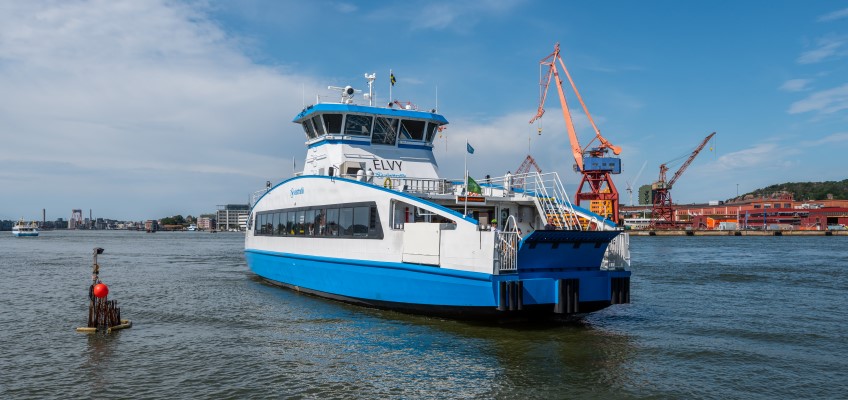Conditions and policy instruments for electrified vessels

The Swedish government has commissioned Transport Analysis to investigate the conditions for an increased use of fully or partially electric ships in Sweden, and to investigate possible incentives to achieve an increased port electrification. The results are presented in this report.
Read/download publication
There are some twenty electrified vessels in Sweden. The corresponding global figure is roughly 400, which is a fraction of the total fleet size. The number of electric vessels is, however, growing rapidly, albeit from a low level, and good opportunities exist to electrify parts of our maritime transport operations, while there are also limitations.
The term 'electric vessel' encompasses technologies and installations that utilise electricity, such as energy storage or energy carriers, usually in the form of batteries. The electricity as energy carrier can be used to produce power for the entire vessel (battery-electric), for parts of it (battery-hybrid), or for propulsion. Although other alternative fuels such as electrofuels or fuel cells are not included in the analyses in this particular report, they are covered to some extent in the proposed policy instruments, as such technologies are often combined with a battery onboard the vessels. The approach taken in the future studies that we are proposing regarding a number of the policy instruments could also be broadened to include other alternative fuels.
The market for electrified vessels is growing
The potentials and markets for battery-electric and battery-hybrid vessels differ dramatically. Conditions favourable for battery-electric vessels are found primarily in the area of passenger service, which often involves short trips and regular travel to the same ports, and particularly if the need for speed can be kept low. Our analyses of the energy required per trip for passenger and RoPax ferries indicate that the total potential for battery-electric vessels corresponds to 12–20 per cent of the energy usage within that segment. With regard to most other maritime segments, the trips require more energy than current battery installations can deliver.
Conversely, the flexibility associated with battery-hybrid vessels is greater, and the market potential is considered to encompass the entire vessel fleet, as batteries can fill a role in the total energy system onboard, leading to higher energy efficiency and a roughly 10 per cent reduction in fuel consumption. Such vessels are not dependent upon charging current, although it is beneficial.
Port electrification goes hand in hand with vessel electrification
The electrification of our ports via infrastructure for charging current and shore-side power goes hand in hand with the development of electrified vessels. Sweden is a European leader in terms of the number of ports which offer some form of shore-side power, although total usage of shore-side power is low. According to our calculations, shore-side power accounts for just 5 per cent of the total energy used by dockside vessels in Sweden. The rest of the energy is produced onboard, mainly by diesel-powered generators. Negotiations are underway at the European level which, all things considered, will result in heavier requirements in terms of Swedish ports' offerings of and use of shore-side power by vessels, but this is a costly process for both ports and shipowners.
Transport Analysis calculations indicate that roughly 700 GWh are needed annually to meet the demand for shore-side power from all port calls in all our ports, excluding smaller passenger vessels. Added to this is an estimated 175 GWh in charging current, yielding a total of some 900 GWh. This figure may be compared to the estimated amount of electricity consumed by vessels in 2020, which totalled 34 GWh. The capacity demand may serve as the basis for future mapping of the need for investments in building out electrical infrastructure in ports, and how it can be integrated into the electrical grid. This information is reported as one of the measures in the Swedish government's electrification strategy and is not included in our report.
Even as emissions from domestic road transport have decreased over time, greenhouse gas emissions from domestic maritime transport are increasing, which points to a need for policy instruments to accelerate the transition of our maritime transport operations. The long service lives that vessels have are also contributing to the relatively slow pace of the transition of our vessel fleet compared to the transition of our road vehicle fleet. The maritime segment will require subsidisation in this still early phase of its transition in order to stimulate market growth and achieve the electrification of ports and vessels more quickly. An increased degree of electrification, where possible, will entail a comparatively suppressed demand for the other alternative fuels that will be needed for the transition of our maritime transport operations, such as biofuels with limited availability. Available volumes of alternative fuels can then be directed towards those segments and vessels whose operational requirements make electrical operation unfeasible.
International policy instruments are important to maritime transport
Policy instruments already exist to encourage increased climate adaptation in the maritime sector, and they offer indirect support for electrification as well. However, most reports and studies indicate that additional policy instruments will be needed to climate-transition our maritime transport operations, even assuming extensive improvements in energy efficiency and fuel switching. This applies in particular to our national maritime transport operations, which are not covered by EU policy, including the Fit for 55 proposals. Transport Analysis also finds that there is a need for policy instruments that will steer us towards the increased electrification of both ports and vessels. This is particularly valid insofar as conventional vessel fuels are tax-exempt, which contributes to a switch to alternative fuels entailing major cost increases compared to switching fuels for road transport.
Greater energy efficiency will play a key role in the ongoing electrification process in Sweden, and in the achievement of our national electrification aims. Policy instruments to expand electrified maritime transport should consequently include measures to increase energy efficiency. The long service lives that vessels have entail that such policy instruments should cover not only newbuilds but also existing tonnage and rebuilds.
A great deal of work is being done to create new and to further develop existing maritime policy instruments, both globally within the International Maritime Organization (IMO) and within the EU. Various policy measures have been proposed in Sweden as well, e.g. in a current Transport Analysis report on climate policy instruments for the transport sector, in which one of the background reports analyses a number of different climate policy instruments for the maritime sector. These existing and proposed policy instruments are not included in our report, although the most important ones with a bearing on electric maritime transport are summarised, as they are of major importance to the total picture and to the policy instruments we are proposing, and consequently need to be viewed in a single context.
It is believed that the proposals in the EU Commission's Fit for 55 package will have a pervasive impact on maritime transport. The package includes proposals regarding emission rights trading for maritime transport, carbon dioxide-based fuel requirements, and requirements to offer and use shore-side power and to tax vessel fuels. Implementing Fit for 55 could increase the costs of emissions, and thus incentivise investment in the electrification of maritime transport. Swedish policy instruments should be configured so as to support and, to some extent, complement the ongoing European and international initiatives.
